#Battle of Paoli
Photo










The Battle of Paoli (also known as the Battle of Paoli Tavern or the Paoli Massacre) was a battle in the Philadelphia campaign of the American Revolutionary War fought on September 20, 1777.
#Paoli Massacre Monument#Battle of Paoli#Battle of Paoli Tavern#Malvern#Paoli Massacre#Philadelphia campaign#20 September 1777#US history#245th anniversary#American Revolutionary War#tourist attraction#landmark#free admission#American War of Independence#Paoli Battlefield Site and Parade Grounds#Paoli Massacre obelisk#landscape#countryside#original photography#summer 2016#flora#woods#forest#lawn#snake fence
3 notes
·
View notes
Photo

TDIH: The Battle of Germantown
On this day in 1777, Americans lose the Battle of Germantown—at least technically. In an odd sort of way, Germantown was a morale booster, too. Washington’s army had launched a surprisingly tough attack at a time when it was believed to be down and out.
The conflict at Germantown occurred in the wake of American losses at Brandywine and Paoli. It also followed the British occupation of Philadelphia on September 26, 1777. Not too long after that occupation, General William Howe decided to position a large portion of his forces at Germantown, several miles outside of Philadelphia. He wanted to be able to defend the city from an advance by Washington’s forces.
In the meantime, Washington’s army was in rough shape. They lacked supplies and even some of the basic necessities. But, as the Pennsylvania Historical and Museum Commission describes, “their morale was good and they were still full of fight.”
The story continues here: https://www.taraross.com/post/tdih-germantown
#tdih#otd#this day in history#history#history blog#American Revolution#revolution#america#freedom#liberty#sharethehistory
4 notes
·
View notes
Photo

In seventeen sixty nine a child was born
in Corsica, Genoa's former vassal state.
Prior to his birth, his land had been war-torn,
Paoli's resistance did his birth predate.
At school, his geometrical talent was inborn,
and he was tutored by none other than Laplace.
For his accent, his peers at school laughed him to scorn,
but fortune would elevate him from grass to grace.
With his much older heartthrob he tied the knot;
much to the chagrin of his own dear family.
For the heart of Josephine he relentlessly fought,
and at Chateau de Malmaison they lived happily.
Later he would choose a military career
that would take him beyond the Corsican frontier.
France's revolution saw to his glorious rise,
when at Toulon, he took royalists by surprise.
To Egypt he led a dual expedition
of a military and scientific mission.
To France he returned and sacked the directory,
taking charge of the affairs of state and treasury.
Europe did contend with him in seven coalitions;
at Austerlitz he subjugated two nations,
at Marengo, Austria on her bended knees fell,
at Jena-Auerstadt, Prussia to victory bade farewell.
At Borodino, Russia met her nemesis,
as her vanquished forces saw their paralysis.
At Ligny, Blucher like a beaten canine fled
with the terribly smitten forces he once led.
Portugal's sovereign lord to distant Brazil ran,
when like an invincible lord he came to his realm.
The emperor he feared, and made no military plan;
thus he paved the way for him to ascend his helm.
But despite his triumphs, his weakness was exposed.
At Rolica, his troops a major set back saw.
From Leipzig he did to Elba's island withdraw,
from whence in 1815 he returned unopposed.
Russia's wintry plains did his grand armee deplete,
making his troops vulnerable to a future defeat.
After the famous battles in which he gloried,
his great ambition at Waterloo was buried.
1 note
·
View note
Text
The Ghost of General ‘Mad Anthony’ Wayne and his Missing Bones


Photos provided by: UnchartedLancaster.com
“Anthony Wayne was an American soldier, officer, and statesman during the Revolutionary War. His daring military exploits and fiery personality quickly earned him a promotion to brigadier general and the nickname “Mad Anthony.”
Wayne is probably the second most frequently sighted ghost on the East Coast. Second only to Abraham Lincoln. He is also the only Pennsylvanian known to have two separate graves, with body parts in both."
"George Washington considered Wayne to be one of the best tactical commanders and military strategists of the Revolution.
Wayne was born on January 1, 1745, near Paoli in Chester county. He received an excellent education and worked as a surveyor for Benjamin Franklin. When the Revolutionary War began, he assembled a militia and became colonel of the 4th Regiment in Pennsylvania. Wayne aided Benedict Arnold and saved Washington’s troops from a massacre at the Battle of Brandywine in September 1777.
Wayne was at Valley Forge during the winter of 1777-1778, where the Continental Army recouped and rested. Wayne led men to more victories when fighting resumed, including a decisive battle at Stony Point along the Hudson River.
After the war, Wayne settled in Georgia on land granted to him for his military service. He briefly represented Georgia in the House of Representatives before returning to the Army to accept command of U.S. forces in the Northwest Indian War. His forces defeated the Western Confederacy, an alliance of several Native American tribes, at the 1794 Battle of Fallen Timbers, and he masterminded the Treaty of Greenville, which ended the war.

Photo provided by: HistoryLink
Two years later, Wayne died on December 15, 1796, in Erie, Pennsylvania, at Fort Presque Isle while on active duty. He was 51.
Following his wishes, Wayne, wearing his uniform, was buried two days after his death in a plain wooden coffin at the foot of the flagstaff of the post’s blockhouse. The top of the coffin bore his initials, age, and the year of his death in brass tacks.
Had it not been for a strange twist of fate, “Mad Anthony” Wayne would have laid there in peace for eternity.
For 12 years, the remains of Wayne remained undisturbed in a plain grave. However, some thought his burial was not fitting for such a great war hero, and in 1809 Wayne’s family decided to bring him home to rest in St. David’s Church Cemetery closer to his home in Radnor Township, not far from Valley Forge.
When Wayne’s son Colonel Isaac Wayne had the coffin opened in Erie, everyone was shocked! Instead of a crumbling pile of bones, they found a body in an excellent state of preservation.
Isaac had come ill-prepared to move an entire body across the state.
A local physician, Dr. James Wallace, came up with a remedy. He suggested they put Wayne’s body in a large vat and boil it to separate the flesh from the bone.
The general’s flesh and clothing were reinterred beneath the blockhouse. Meanwhile, Isaac took his father’s bones in the back of a wagon and made the long 400-mile journey across the state along what is now U.S. Route 322.
This may be hard to believe, but Pennsylvanian roads were even worse in the early 1800s. They were bumpy paths full of rocks, ruts, and tree stumps.
When Isaac finally arrived at the gravesite and attempted to reassemble the skeleton, the family discovered to their horror that several of the bones were missing. It appeared that some of the bones had fallen out of the wagon while making the arduous trip across the commonwealth.
Isaac was greatly distressed by this turn of events and regretted his decision to disinter his father for the rest of his life.
After that, stories began to surface that every New Year’s morning, General “Mad Anthony” Wayne’s birthday, his ghost rises and begins the long journey on horseback from St. David’s to Erie and back in search of his missing bones. People along that route have insisted that a man clad in Colonial garb has been seen riding a horse and stopping if searching for something.
“Mad Anthony’s” ghost has been seen throughout Pennsylvania, including along Route 1 near Chadd’s Ford, where the Battle of Brandywine occurred and at Valley Forge National Park. There have also been sightings in New Jersey, New York, Virginia, and Canada.
Sometimes Wayne is astride his trusty steed Nab, described as possessing fire-flashing hoofs.
Whether alone or on horseback, Wayne’s ghost looks fierce and determined, as though he is still waging battles against the British and Germans.”
Story provided by: UnchartedLancaster.com
1 note
·
View note
Text
Weather elk grove village tuesday

#Weather elk grove village tuesday plus#
He humorously reminisced about praying to God to help him keep it together during the performance, one he played while high on L.S.D. Mathews, percussionists Karl Perazzo and Paoli Mejias and vocalists Andy Vargas and Ray Greene.Īfter “Europa,” Carlos went into a long rap about Woodstock ’69. Santana then shifted the mood with his fantastic ballad, “Europa.” It boasted a delightfully hesitant rendering of the soaring melody and unexpected avenues in his solo, when he rolled the treble off his guitar giving it what Clapton called “the woman tone.” On this and every number, Santana was supported by a first-rate row of players including longtime bassist and former Miles Davis sideman Benny Rietveld, keyboardist David K. The band then cooled things down by serving up some of their hit ballads including “Head to the Sky,” “That’s the Way of the World” and “After The Love Has Gone,” before upshifting to more high-energy favorites – “Boogie Wonderland,” “Let’s Groove” and the set closer “September.” The whole affair seems largely directed by the powerful centerstage presence and thumping bass of Verdine White. The entire band is as tight “as a mosquitoes’ tweeter” to quote another great musician, Nina Simone. Even at 71, Bailey hits all the high notes, probably the highest of high notes in all of music, at least since they stopped cranking out operatic castratos in the 17th Century! His son, Phillip Bailey Jr., shares both the lead duties and otherworldly vocal instrument of his father. The most striking aspect of an EW&F performance is the undiminished state of Phillip Bailey’s soaring falsetto voice. They hit the ground running at Bethel with an uninterrupted string of eight high-energy hits including “Shining Star,” “Getaway,” “Serpentine Fire,” “Sing A Song” and “Got to Get You Into My Life.” The focal points are the three founding members still performing today – the always smiling bassist Verdine White, percussionist and vocalist Ralph Johnson and the extraordinary lead vocalist Phillip Bailey. Even without the presence of their founder and leader, the late Maurice White, the 12-piece band put on a staggeringly energetic and hit-packed show. These are songs that have lived on as samples powering hits by new generations of artists, from Drake to A Tribe Called Quest to Bjork. They are one of the most successful acts in history, selling over 90 million albums, with a litany of Billboard charting singles that betters most acts of their era. Though they are enshrined in the Rock & Roll Hall of Fame and have earned a boatload of Grammy Awards and other honors, Earth Wind & Fire just don’t seem to get the respect they truly deserve.
#Weather elk grove village tuesday plus#
The show Sunday, August 21 at Bethel Woods was made even better by the staggering 90-minute plus opening set by Earth, Wind & Fire. As always, he was again backed by an ace band that served up the crowd-pleasing hits and a few surprises. Each and every time, Santana would rise to the occasion and spit with his guitar “sapphire bullets of pure love,” quoting McLaughlin. The fourth was also at Bethel Woods, in the summer before Covid-19 descended to darken stages and our lives. My third live experience was when he was even deeper into his jazz phase, a 1988 performance at the Saratoga Jazz Festival with a band co-led by Miles Davis and Weather Report saxman Wayne Shorter. The first two were in the early and mid-‘70s respectively, shortly before and then after his embrace of guru Sri Chimnoy and his legendary guitar battles with another Chimnoy acolyte, jazz fusion great John McLaughlin. I have had the pleasure of seeing Santana live on at least five occasions.

0 notes
Photo

Painting of Richard St. George by Thomas Gainsborough (1776) He Survived His Tour of Duty In America With A Silver Plate In His Head, Only To Later Be Murdered In Ireland~
Rendered just before the young St. George shipped out for New York to fight against the growing American Revolution.
The brutality of war came as bone-chilling shock. In a letter completed right after the Battle of Paoli in 1777, he wrote that “the battles were not like the theaters back home in London and Dublin.” “At Paoli he witnesses and participates in a battle unlike any battle he had fought in before." "It was a nighttime surprise attack by the British army on Anthony Wayne’s troops and they went into Wayne’s camp without loading their muskets. They just planned to use their bayonets, and it was an extremely bloody affair. He called it a ‘scene of havoc.’ A few days later, a shaken St. George was wounded in the head at the Battle of Germantown. He underwent a gruesome operation that opened up his skull, replacing a portion with a fitted silver plate.
St. George eventually returned to Ireland, where he covered his silver plate in public by swathing his head in a black silk scarf like a turban, and wearing a long, somber black robe, a reflection perhaps of his darkening mental state.
He experience strange fits of melancholia, which he medicated with dashes of laudanum, or tincture of opium. He married and had two sons. But his wife died in 1791, and St. George entered a deeper melancholic reverie.
By then, in the late 1790s, unrest was spreading across the Irish countryside, and to St. George’s alarm, peasants began chopping down trees across his huge land holdings to fashion pikes. (St. George’s estates covered an area larger than Manhattan.) Rather than seek accommodation, St. George threatened his impoverished tenants with jail and eviction, and dared them to attack him. They did, murdering him in a spasm of barbarity in February 1798. The subsequent rebellion was put down by the English a few months later.
Credit: National Gallery of Victoria, Melbourne, Felton Bequest, 1922
#St George#Irish#gentry#gentleman#british army#battle of paoli#1700's#american revolution#history#colonial america#richard st george
35 notes
·
View notes
Text
Bought this as a lot at auction. Maybe you guys can help me out?
Here we have Battle at the Pyramids. The second picture is the back. Is THIS the original??


And then we have 1807 Friedland Napoleon

And lastly, France Pittoresque. "Napoleon et Paoli", "Maison de Napoleon a Ajaccio", and Napoleon and these other dudes.

#napoleon#napoleon bonaparte#antiques#battle at the pyramids#friedland#france pittoresque#Ajaccio Corsica#Pasquale Paoli
18 notes
·
View notes
Photo

British light infantry of the 40th Foot assaulting American rebels during the battle of Paoli, September 20 1777. The engagement earned them the nickname “the Bloodhounds,” while the Pennsylvanian brigades they had savaged swore revenge. The light infantry subsequently wore red feathers in their hats, partly as a mark of pride in their victory, partly ‘to prevent anyone not engaged in the action from suffering on their account.’
Detail from A Dreadful Scene of Havoc by Xavier della Gatta, 1782.
#history#military history#revwar#american war of independence#18th century#british army#paoli#paoli's tavern#paoli massacre#battle of paoli#light infantry#british light infantry#american revolution
50 notes
·
View notes
Text
One of my problem with English is that it doesn’t have a word for “fusillés”.
Sure, you can say they were shot. And for “fusillés à l’aube”, shot at dawn.
But shot itself could be shot in battle, it doesn’t convey the full meaning of “fusillé”, which is executed, by firearms specifically yes, so shot, but the important notion being executed, sentenced to death
and it feels wrong, inexact, and even disrespectful, to say Robespierre PAOLI, born the 6th July 1908 in Prunelli-di-Casacconi (Corsica), WW2 soldier in the 8e régiment de tirailleurs sénégalais, was shot by the Nazis; he was executed as a war prisonner in Walfach (Germany), the 17th April 1945, less than a month before the Third Reich surrendered. He was, like his namesake, 36y old.
source
#people named after robespierre#ww2#his full military record isn't online it's too recent#there's sth about being corsican and not named after the famous corsican napoleon bonaparte#but after a northern french lawyer#his parents must have been true republican <3
44 notes
·
View notes
Photo

Hendrik Kobell - Portrait of general Pascal Paoli - 1768
Filippo Antonio Pasquale de' Paoli FRS (French: Pascal Paoli; 6 April 1725 – 5 February 1807) was a Corsican patriot, statesman and military leader who was at the forefront of resistance movements against the Genoese and later French rule in the island. He became the president of the Executive Council of the General Diet of the People of Corsica, and also designed and wrote the Constitution of the state.
The Corsican Republic was a representative democracy asserting that the elected Diet of Corsican representatives had no master. Paoli held his office by election and not by appointment. It made him commander-in-chief of the armed forces as well as chief magistrate. Paoli's government claimed the same jurisdiction as the Republic of Genoa. In terms of de facto exercise of power, the Genoese held the coastal cities, which they could defend from their citadels, but the Corsican republic controlled the rest of the island from Corte, its capital.
Following the French conquest of Corsica in 1768, Paoli oversaw the Corsican resistance. Following the defeat of Corsican forces at the Battle of Ponte Novu he was forced into exile in Britain where he was a celebrated figure. He returned after the French Revolution, of which he was initially supportive. He later broke with the revolutionaries and helped to create the Anglo-Corsican Kingdom which lasted between 1794 and 1796. After the island was re-occupied by France he again went into exile in Britain where he died in 1807.
Hendrik Kobell (13 September 1751 – 3 August 1779) was an 18th-century landscape and marine painter, etcher, draftsman and watercolorist from the Northern Netherlands.
He came from a painting family and was a cousin of Ferdinand Kobell and Franz Kobell, German painters and brothers. His father was a pottery merchant, and though he was not a professional artist, he trained his son in drawing, who loved to draw ships in the port of Rotterdam. The younger Kobell was finally able to take a journey in one when his father arranged some business he could attend to in London in 1779. There he conducted his business while drawing all sorts of ships and boats, and when he returned to the Northern Netherlands in 1770, he gave up the pottery business to study art in Amsterdam. He studied for two years under Jacob de Vos and Cornelis Ploos van Amstel with such success that he was elected a member of the Stadstekenacademie (Amsterdam drawing academy). He travelled to Paris in 1772 and in 1772 settled in Rotterdam, where he helped set up a similar drawing academy; Genootschap Hierdoor tot Hooger.
He painted in oils and watercolors, doing landscapes and marines. His work is distinguished by skillful manipulation and lifelike depiction. His work as a draftsman and etcher was also notable. He was esteemed for his numerous drawings, executed in pen and heightened with India ink.
He was the father and teacher of the painter Jan Kobell II (1778–1814), and his other pupils were Carel Frederik Bendorp, and Gerrit van der Pals.
5 notes
·
View notes
Text





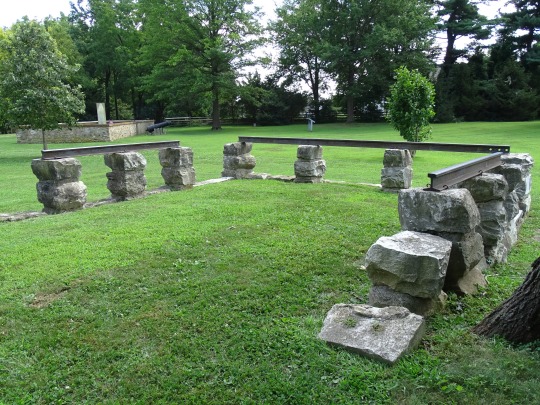

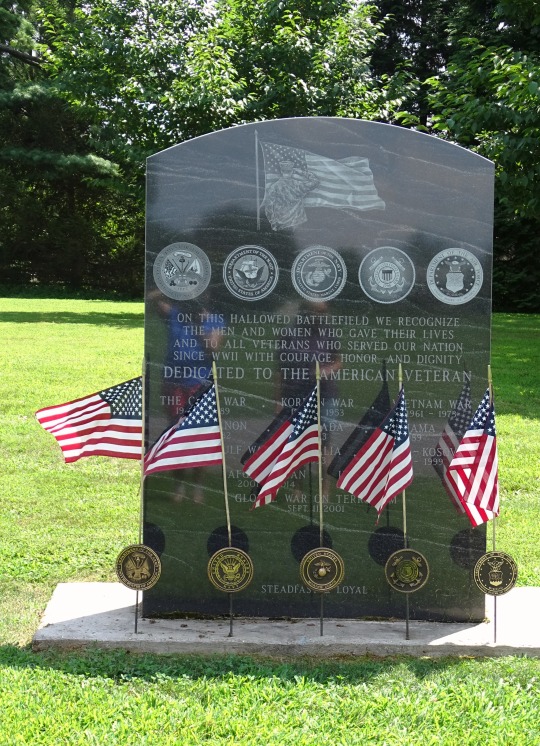






The Battle of Paoli (also known as the Battle of Paoli Tavern or the Paoli Massacre) was a battle in the Philadelphia campaign of the American Revolutionary War fought on September 20, 1777,
#Battle of Paoli#Battle of Paoli Tavern#Battle of Paoli Tavern or the Paoli Massacre#Paoli Massacre#20 September 1777#American Revolutionary War#American War of Independence#Paoli Battlefield Site and Parade Grounds#Mid-Atlantic region#Chester County#Chesco#Paoli Massacre obelisk#Malvern#Philadelphia campaign#Pennsylvania#summer 2019#free admission
1 note
·
View note
Photo
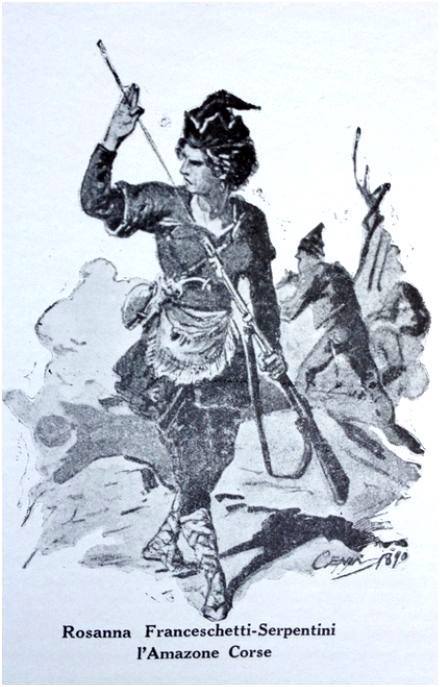
Rosanna Franceschetti-Serpentini and other Corsican heroines
In 1729, the island of Corsica was under the rule of the republic of Genoa, Italy. The local people rose against their overlords, which led to a conflict that lasted forty years before being fully resolved.
Many women distinguished themselves during this struggle. One of them was the daughter of the rebel leader Fabio Vinciguerra. Described as being of a warlike disposition, she swore revenge when her father was assassinated by the governor. Taking the head of his troops, she was known for the brutality with which she fought the Genoese soldiers. In 1739, the wife of Bartolo of Barbaggio acquired similar fame for her courage in battle.
In 1746, Faustina Gaffory, defended her home in Corte from the Genoese with a handful of companions. Seeing their energies falter, she showed her comrades a powder barrel and threatened to blow-up the house. The defenders thus kept fighting.
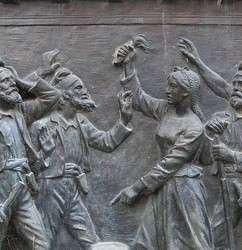
In 1761, the women of Tenco defended their town. One of them, Josephine Jacobi armed herself and joined the fray. Other women imitated her and fought. Animated by their example, the defenders repelled the besiegers.
Several women fought at the battle of Borgo in 1769 on the side of the Corsican patriot and military leader Pasquale Paoli. Magistrate and memorialist Salvatore Viale described them as armed with rifle and knife, sharing the perils of war with their husbands.
Among them was Rosanna Franschetti-Serpentini who fought alongside her husband, an officer. She was dressed in male attire and “always well armed”. She was nicknamed “the heroine” or “our captain”. Rosanna notably defeated a French officer in hand-to-hand combat (since French troops had landed in Corsica after Genoa sold the island to France). When she saw that her side had to retreat, she freed her captive and said: “Remember that a Corsican woman overcame you and gave you back your sword and freedom”.
Bibliography:
Aimé André, Histoire générale de la Corse depuis les premiers temps jusqu'a nos jours, vol.2
Albertini Jean-André, Orsatelli Andrée, Corté et la renaissance de l'université corse
Bessières Luc, Panthéon des martyrs de la liberté, ou histoire des révolutions politiques, et des personnages qui se sont dévoués pour le bien et la liberté des nations, etc.
Ettori Fernand, Mémorial des corses
Fillipi Antoine-Baptiste, La corse, terre de droit: Essai sur le libéralisme latin et la révolution philosophique corse (1729-1804)
Gio Pietro Vieusseux, Archivio storico italiano: ossia raccolta di opere e documenti finora inediti o divenuti rarissimi riguardanti la storia d'Italia, vol.14
Gregorovius Ferdinand, Corsica in Its Picturesque, Social, and Historical Aspects: The Record of a Tour in the Summer of 1852
Pomponi Francis, Émeutes populaires en Corse : aux origines de l'insurrection contre la domination génoise (Décembre 1729 - Juillet 1731)
Renucci Francesco Ottaviano, Quattro storiche novelle
Malaspina Toussaint M., “La Corse”, Revue politique et littéraire: revue bleue
#history#women in history#Faustina Gaffory#Josephine Jacobi#Rosanna Franschetti-Serpentini#corsica#Corsican history#18th century#warrior women#france#french history
80 notes
·
View notes
Text
About the discourse on gender/orientation discrimination in Italy
I've pondered a lot about writing something on this topic. I'm hardly an expert and I'll fall short for sure, and I don't even know if anyone cares.
The thing is... I feel like the outside perception might be a bit skeeved (correct me if I'm wrong). We've had some relevant pieces of media achieving international success (e.g. Call Me By Your Name), and I'm really chuffed that Måneskin are becoming some sort of queer icons - but please be aware that we (as a country) have a looong road ahead.
And while I don't feel much equipped to open up a debate about it, what I'm not seeing on my dashboard is any mention (especially not in English) of this speech, which rocked the boat quite a bit here.
So, the least I can do is trying to translate it at the best of my abilities, just to give you an idea about what kind of mindfuckery we're going through.
Some context:
a law against discrimination is currently being discussed in Parliament. Copy-pasting from here:
The Zan Law aims to contrast all discrimination and violence on the grounds of sexual orientation, gender, gender identity and disability. Numerous artists, social influencers and personalities from the world of show business, in particular the famous rap singer Fedez, have spoken out in favour of it, pointing the finger at the Right League (Lega), which has repeatedly blocked its agreement.
Fedez (sidenote: while his music is not my cup of tea, he's a brilliant businessman and activist imho) has been invited to the big music festival we host every year for the 1st of May - which is televised by RAI, the public national broadcast (more specifically on the RAI3 channel). His speech was deemed controversial and "inappropriate" by the RAI higher-ups, but he chose to speak anyway.
Here it is, under the cut, with a few thoughts about it.
(TW: mentioned homophobia)
" When I got on this stage they asked me: “1st of May: tell us about a first time” - and indeed today has been a “first time” to me.
It’s the first time I’ve forwarded a speech for approval by political institutions; approval that was, unfortunately, denied at first, or better said: the RAI3 top management asked me to omit names, to omit political parties, and to sugarcoat its contents.
I had to fight a bit (a lot) but in the end they allowed me to speak freely.
I take full responsibility and all the consequences of what I’ll say and do; however, be aware that this speech’s content has been described, by the deputy manager at RAI3, as “inappropriate”.
[t.n.: talks briefly about the show business jobs crisis due to the pandemic and the need for welfare and reforms, as it’s the national workers' holiday]
Now comes the stronger stuff; that was just the “pre-approved” part of the speech.
A couple of words about the man of the hour: Ostellari (t.n: Lega Nord and Senate member). So, he sanctioned that a law proposition by the Parliament (therefore the utmost expression of the people, already approved by the Chamber of Deputies) like the Zan Law could have been blocked by one individual’s attention-seeking, e.g.: he himself.
After all, Ostellari is a member of a political line-up which has stood out, over the years, for its battle against equality.
If I may, I’d like to recount some of their “aphorisms”:
“If I had a gay son, I’d burn him in a oven” - Giovanni de Paoli, Lega Liguria regional councillor
“Gays? Let them start behaving like normal people!” - Alessandro Rinaldi, Lega councillor in Reggio Emilia
“Gays: victims of nature’s abomination” - Luca Lepore and Massimiliano Bastioni, Lega regional councillors
(they’ve co-written that one… wondering what they could come up with, each on his own)
“Gays are a tragedy upon reproduction and the conservation of the species” - Alberto Zelger, Lega town councillor in Verona
“Gay marriage leads to race extinction” - Stella Khorosheva, Lega candidate
The last one… this one… there’s a touch of fantasy in there (laughs):
“They give injections to babies to make them gay” - Giuliana Livigni, Lega candidate
Somebody, like Ostellari, has said that we have more pressing priorities in this time of pandemic, as compared to the Zan Law. So, let’s take a look at these priorities. The Senate hasn’t had time for the Zan Law because they had to discuss:
wine labeling
the CONI (t.n: National Olympics Committee) reorganization
the bilingualism compensation owed to the cops in Bolzano
...and, just ‘cause we lack for nothing:
restoring the pension to Formigoni (t.n. former president of the Lombardy region, found guilty of corruption and now detained under custody)
Therefore, according to Ostellari, Formigoni’s pension is more important than protecting everyone’s rights, and the rights of those who are discriminated against on a daily basis, even to the point of violence. ,,
---
I don't quite know what to make of this, guys. It's disheartening, really.
It's sad that, in the year 2021 a.C., we have to fight nail and tooth for a damn anti-discrimination law (to have it approved and to have it discussed in the first place. But I guess wine labeling is paramount).
It's appalling that all the quotes mentioned above are coming from "legit" politicians who are in charge of public institutions, and from a political party which has been sadly gaining consensus over the last years. (and I'm not even getting started on their racism. The Lega, simply put, is fucking fascism).
It's unbelievable that a private citizen, albeit in the public eye, like Fedez has had to fight for his freedom of speech. There's a recording of a (quite heated) phone call between him and the RAI management, where they basically try to exert censorship on his words. Idk, maybe I'll try and translate that one, too.
... I'll see myself out. Thank you for reading.
#italy#Zan Law#DDL ZAN#gender equality#anti discrimination#Fedez#TW: homophobia#fuck censorship#fuck fascism
13 notes
·
View notes
Text
Benjamin after participating in Brandywine, Paoli, and Germantown: It cannot get worse than this.
Narrator: It did get worse. Benjamin would end up going AWOL after the Battle of White Marsh to chase after a deserting soldier who ended up dying anyway, in the house of a congressman who has been ignoring Benjamin’s pleas of help for weeks. He would then end the night by crying himself to sleep in a guest room while the future love of his life watched awkwardly from the stairs. And that is only December-
#listen I just think. it’s kinda funny#it’s kinda fun#it’s fun for me at least#amanda rambles about ss&sp (again)
12 notes
·
View notes
Text
Gillivia First Meeting
Lafayette woke up due to shouting, he quickly put on his uniform to see what was going on. French and American soldiers were fighting, Lafayette knew that there were tensions through the men, but he never knew it would get this bad. Before General Washington or Lieutenant General Comte de Rochambeau could say anything, he heard a voice.
“One…” a woman counted in a low, but commanding voice. Those who heard it turn to her, only to freeze in shock. The woman was wearing the deadliest, most cold, and most terrifying glare that Lafayette had ever seen.
“Two…” Now all of the soldiers were looking at her in shock and fear.
“Three…” The woman jumped off her horse and the Major General could finally get to observe all of her: she was wearing a red dress under her black cloak, her fiery red hair was braided into a plait and hanging over right shoulder, her violet-blue eyes reminded him of his friend; Lieutenant Colonel Alexander Hamilton, she had freckles dotted across her cheeks, nose, and ears, and had pink-red lips.
“Ah...I thought you were arriving the day after tomorrow, my daughter?” son général asked. Wait what?! My daughter?! She doesn’t look a thing like George Washington!
“Yes, Papa, but traveling through New York to Valley Forge as a Patriot is no easy feat.” The unknown woman mused, “I would be in a blue dress, but I thought it would be easier in red. New York and Pennsylvania are full of lobsters and loyalists.”
She looked at General Washington’s hair, face full of amusement and exasperation, “And you still have your potato hair,” she tsked her tongue, “I feel so sorry for you.” Snorts and laughter were heard around the men at the joke.
Finally, the commander in chief of the Continental army introduced the woman to the camp. “Everyone, this is Olivia Rachel Hamilton, she is a very important and very special asset in this war against the British. I expect you all to welcome her or welcome her back with open arms and respect her.”
Olivia Rachel Hamilton, where had he heard of that name before? Right! She participated in the Battle of Brandywine, Battle of Paoli, Battle of Setauket, she was with her brother during the Schuylkill River Incident, trained the under-trained soldiers, kept the army fed, and nursed the wounded back to health. Lafayette had heard of her name throughout the year about how kind, brave, and caring she was and her unknown reason to depart from camp. Yes, he had heard of her, but never seen nor met her.
He had heard some of the French and American soldiers, who obviously didn’t know her well enough as to why Washington would ask them that, especially of a measly woman even if she was Hamilton’s sister, he had heard slurs about her from her appearance down to her accent.
General Comte de Rochambeau introduced himself to Olivia with the help of translating from her twin brother.
“And Olivia this is-” General Washington got cut off by Olivia, “Major General Marie-Joseph Paul Yves Roch Gilbert du Motier, Marquis de Lafayette, yes I know exactly who you are, monsieur.” Her Nevis accent was more pronounced when she spoke French. Upon hearing her say the French word perfectly, the soldiers from France froze.
“Oui, je connais le français avec l'espagnol, le danois, l'hébreu, le grec, le latin et l'italien. Voulez-vous savoir pourquoi le général Washington vous a demandé cela? Ce n’était pas à cause du rang de mon plus jeune frère jumeau, c’était parce que je l’avais mérité, par moi-même. Ne sous-estimez pas les femmes mais ne les surestimez pas non plus, ce sera votre chute avec votre fierté et votre ego. Bien que j'aime plutôt être sous-estimé, le choc sur ceux qui en ont est assez amusant, si je le dis moi-même.”
"Via, vous n'êtes plus âgé que de 30 secondes."
“Oui, Xander, cela signifie que je suis sur la bonne Terre de Dieu depuis 30 secondes avant toi.”
Lafayette could feel a start of a fight and so did Washington as he reminded Olivia about the introduction. “Ah! Yes, of course, Papa. It was a pleasure to meet you, Marquis.” Before anyone could start talking, she spoke again, “Now if everyone would excuse me, I need to take a nap, my journey was not a relaxing one.” She nodded and walked inside Alexander’s tent with said man escorting her.
She is one interesting lady Lafayette thought, before having sleep taking over him once again.
.
.
.
Translations:
-his General
-“Yes, I know French along with Spanish, Danish, Hebrew, Greek, Latin, and Italian. Do you want to know why General Washington asked that of you? It wasn’t because of my younger, twin brother’s rank, it was because I had earned it, by myself. Do not underestimate women but don’t overestimate them either, it will be your downfall along with your pride and ego. Though I rather like being underestimated, the shock on those who have is quite amusing, if I do say so myself.”
-“Via, you are only older by 30 seconds.”
-“Yes, Xander, that means that I have been on God’s good Earth for 30 seconds before you.”
#oliviarachelhamilton#Olivia Hamilton#marquis de lafayette#turn: washington's spies#turn amc#Alexander Hamilton
10 notes
·
View notes
Text
Star Wars: The High Republic #2 Review
Ultimately a 7.5 out of 10, this installment was slightly better because of how Cavan Scott decided to advance the plot. While there some are nice nuggets of good-story telling and character interactions, even worse than last time, it’s bogged down with cardinal errors that truly make me question Scott’s competency as a writer for this story.
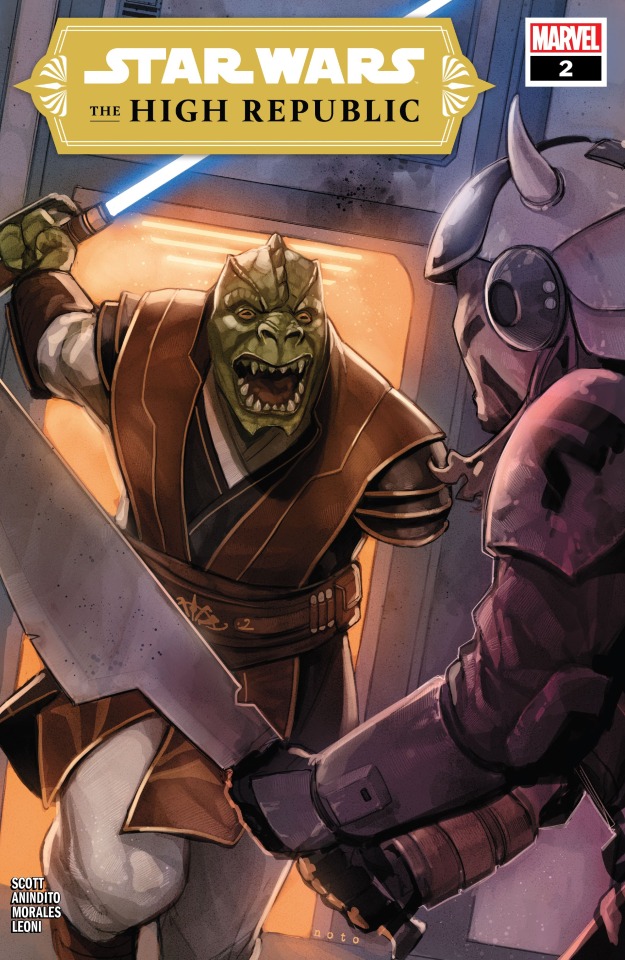
The issue comes right off the back end of Keeve being promoted to a Master Jedi and chronicles her first mission in the position. She is still dealing with the growing pains of what it means to be a Jedi which is depicted with her ongoing internalized self-doubt as well as her difficulty expressing certain Jedi mantras, such as “May the Force be with you.” Arguably exacerbating this bottled up uncertainty are the Keeve-proclaimed legends of Jedi Masters Sskeer, and identical Kobati twins Terec and Ceret. These twins are Bond-twins and as so are able to share the same mind and experiences of each other.

As they exit “hyperspace” (more on that later), the four masters come across the leftover demise of a ship that has been attacked. The Jedi were tasked with responding to the scrambled distress call that the ship had sent out sometime ago but, it seems as if they arrived too late. Both Keeve and one of the twins, using the Force, are able to sense survivors within the ransacked ship. As so, they board and enter. Almost as soon as they are inside, they are met with poisonous Nihilian ovax gas and utilize a device called “rebreathers” to mitigate the effects. Fully aware that the Nihil have raided this ship, they continue their investigation and split up to cover more ground. Traversing in groups of two, Terec – who is accompanying Sskeer – can sense the Trandoshan experiencing extreme trauma which means that Ceret can feel it as well via their bond; specifically, Sskeer is having flashbacks to the exact moment he lost his arm in the Battle of Kur.
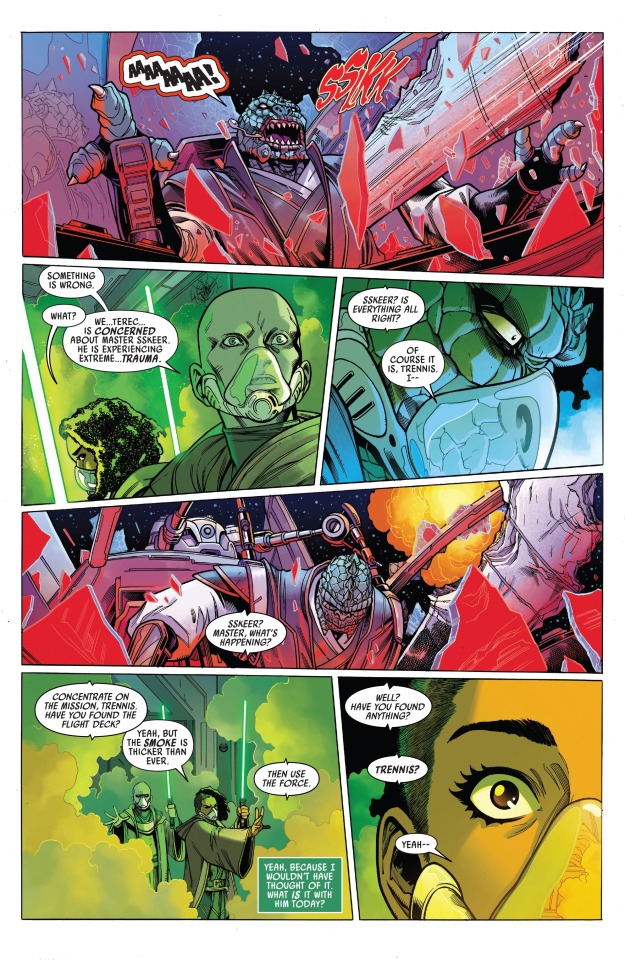
On Keeve’s side of things, she and Ceret come across the corpses of a Hutt and Gamorrean guards. Upon further examination, it seems the Hutt was killed via an amalgam of stab wounds, blaster bolts, and nagnol poisoning – the latter being a toxic natural gas, capable of disrupting starship sensors, poisoning beings based on dosage, and a key element in the Nihil smokescreen.

On Sskeer’s end, he comes across a barley crop and together the Jedi deduce that the Hutt was capitalizing on the grain shortage that has occurred thanks to the Great Disaster. As the twins work on trying to ascertain where exactly the crop came from, Ceret is attacked by a Nihil that has been left behind; this causes both twins to feel the pain but, the wounds are not fatal. Sskeer charges ahead and chases after the Nihil raider, who is already suffering from serious injuries previously sustained in the raid. While Sskeer is perturbed that he cannot sense the attacker he is able to fatally strike down the assailant; coming to gripes that he has just killed, Sskeer goes on a rampage and continually slashes the bifurcated carcass only be brought back to his senses when Keeve addresses him.

Afterward, the Masters relay their findings to Marshall Avar Kriss and with the analysis from Master Maru, come to the conclusion that the barley – specifically Vratixia Renanicus – is a key ingredient in bacta; moreover, the shipment likely came from the Sedri System – principally, Sedri Minor. With this in mind, Kriss assigns Sskeer and Ceret to got to Sedri while she and Jedi Master Rwoh convene with Keeve and Terec to collect the Hutt ship that is breaking trading sanctions. Keeve moves to go with Sskeer but, Sskeer stonewalls her to stay with Terec.

Arriving on the planet, Sskeer is met with unwecolmedness by a citizen, Kalo Sulman who makes it clear that the Jedi’s presence will interfere with the colony’s independence. As the two are discussing, Ceret sees a Rodian in the crops motioning him to come over – as Ceret goes deep into the brush he is attacked by Drengir.

Back on the ship, Kriss and Keeve are discussing the remains of the corpse that Sskeer has left; Kriss reprimands Keeve for not telling her sooner but, also admonishes herself for not looking deeper into the signs the Force were giving her – such as not being able to hear Sskeer’s “song”.
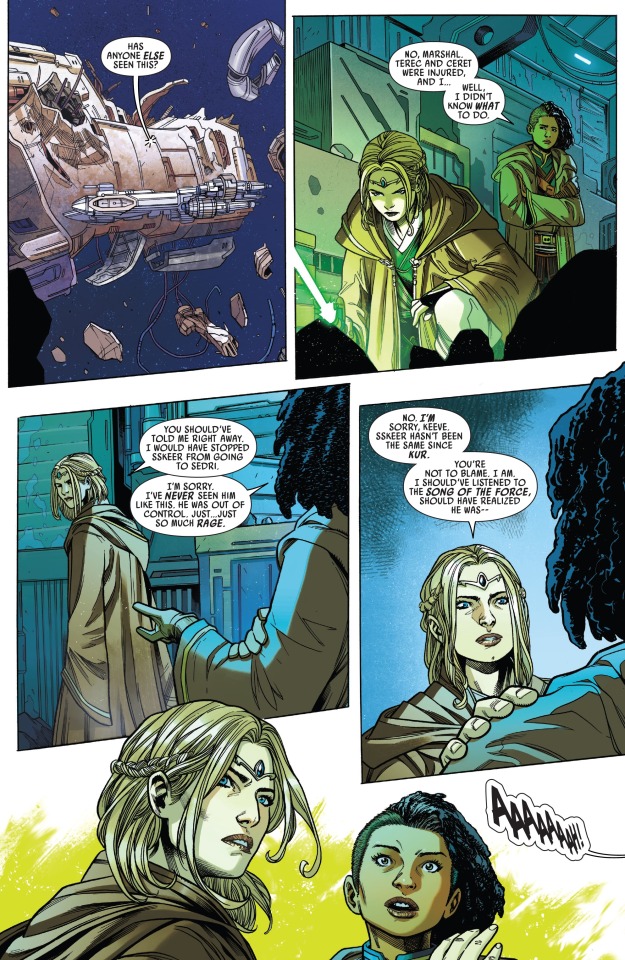
As this happens, Terec – who is being medically assessed by Rwoh – screams out in pain feeling his brother’s anguish and relays this to Kriss. Kriss immediately contacts Sskeer and asks if Ceret is with him; when Sskeer realizes that the twin is gone rushes into the fields only to find his lightsaber.

What I liked:
A growing plot pivoting off of the bacta manufacturing that was touched on by Jedi Grandmaster Veter; this is much welcomed world building within the parameters that is the High Republic.
A very competent and aptly written investigation, analysis, and deductive reasoning done by the Jedi as a whole. The way the Jedi got on the ship, looked for clues, relayed their information to the data analyst/forensic expert, and hash out a plan to go to the planet where the clue originated from was great and definitely resonated with the idea that these Jedi are analogous to Texas Rangers. They certainly seemed like proto-Jedi investigators, not unlike future Jedi Master Tera Sinube.
The continued delving into Jedi Master Sskeer. I like the balancing act that is being conducted with his character. He’s a virtuous being that is dealing with trauma but, that doesn’t, ultimately, stop him from being a Jedi – it just tests it. He is still a “knight” and applies that chivalry when it needs to shine. Witnessing his accident and how it is affecting his psyche, ability to use the Force, and his morality is the highlight of this issue. This is what should be focused on to establish WHY Keeve looks up to him – give her these thoughts in accordance with herself doubt.
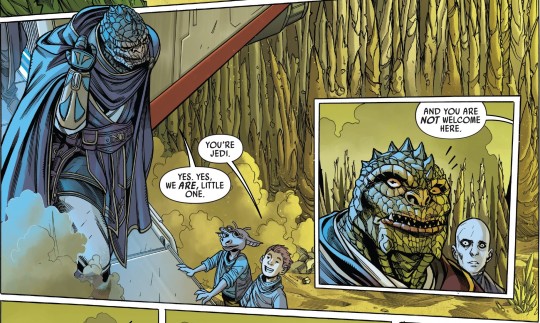
The dynamics of Ceret and Terec as interconnected Force Twins (could be seen as “Dyad Force-bond” inspired). Their link is a double-edged sword that reminds me of the Tomax and Xamot Paoli from Cobra Command. The original Star Wars was centered around Force sensitive twins and it’s nice to see that element played with more here – haven’t really seen that since the Mikkian twin sisters – Tiplee and Tiplar – in Clone Wars.
The holster to the lightsabers – it’s a nice, subtle way to convey how the Jedi of this era are more in a time of peace and reservation. To have a weapon holstered means that they have to take the extra moment to consider brandishing it. This underlying detail syncs really well with the time period considering that most of their enemies would be lifeforms and could be reasoned with – “life is precious.”
This can be seen as succinct yet distinct dichotomy between this era Jedi and the Skywalker Saga Jedi, as their sabers were without a holster and normally fashioned around the hips allowing for both instant access and draw in an age encompassed by war with droids – “droids are replaceable.”

What I disliked:
The application of Keeve’s personality traits continues to feel like a mismatch for the particular time period and volk she supposedly has been training and studying with; Ezra Bridger – who by the High Republic’s standards would not even be a Jedi – acts more like a Jedi than Keeve does. If anything, the uncertainty, quirks, and misapplication of Jedi traditions would have fit Ezra WAY more than it does (or really doesn’t) with Keeve. The concept itself is fine but, the iteration is what is flawed. Keeve is fast feeling more like a Jedi from post revenge Revenge of the Sith – like Kanan Jarrus – that a High Republic Jedi.
The sloppy fan service – there is a scene not only of a Hutt but, the Hutt is dead with its tongue out, surrounded by dead Gamorrean guards. It would be one thing if we just had a dead Hutt, I can even look past the Gamorrean guards (even though it would be nice if we saw this race in more roles than guards – there are some but, it does seem like guards is niche as far as the universe is concerned) but, to also have the Hutt dead with its tongue out to me just screams “DO YOU REMEMBER THAT ONE SCENE IN RETURN OF THE JEDI WITH JABBA?!!!” Just, how much are you going to dilute a reference? Make the fan service substantive and or just not in your face – the Rodian luring Ceret is a good version of fan service; present, notable, but not impeding in terms of the narrative.
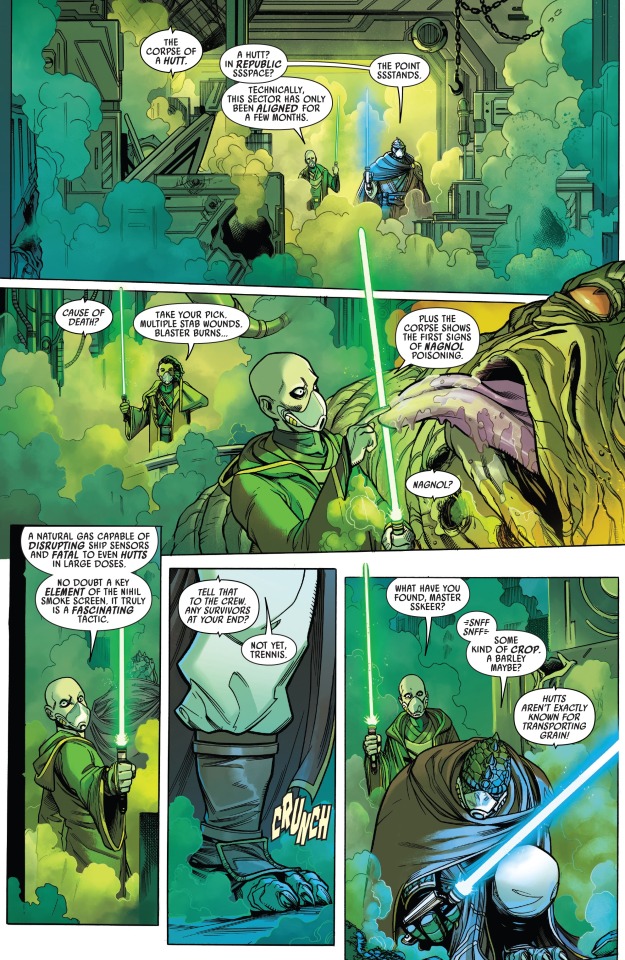
What I Marked Off:
The completely wrong depiction of hyperspace; Star Wars Hyperspace is blue and certainly not immersed in stars when one is traveling through it. This error is on the very first page of the issue. This shook me to my very core and yanked me out of the immersion. IT’S THE FIRST PAGE! HOW DOES ONE MESS UP ON THE FIRST PAGE?!!! To add grave insult to mortal injury, hyperspace is a FOCAL element of the High Republic Era – you CAN NOT mess this up. Ultimately, it’s a team mess up but, Scott gets the brunt of this reprimand because this is his story and arguably his script is the one that should be guiding the artist.
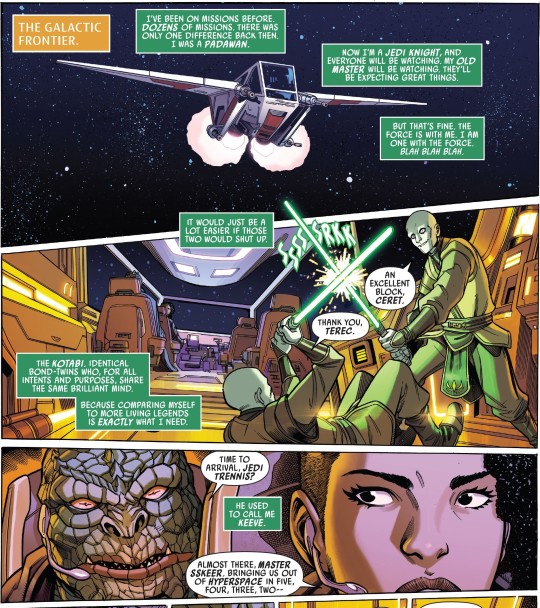
The fact that Scott continues to fail to make the necessary references about crucial dynamics, events, and positions within this era. I had to learn from a YouTube video (link below) that Sskeer is actually the “Steward” to Kriss’ Marshall role. As of issue #3, this position is still not established to be held by Sskeer which is a real shame as it adds more substance and weight to his plight as a perturbed Jedi.
https://www.youtube.com/watch?v=TPeRcyJE5dk&feature=emb_title
In summary, this issue was a 7.5 out of 10; slightly better than issue one because of how the writer decided to advance the plot and who he decided to advance the plot with. The genuinely good moments of story-telling are bogged down by ineptitude that can literally throw one out of the immersion. Nonetheless, if you can tolerate the faults there are elements to enjoy, especially when it comes to the characters. I hope those elements promptly become prominent.
#high republic#cavan scott#keeve trennis#sskeer#vernestra rwoh#kobati#ceret#terec#avar kriss#estala maru#ovax gas#battle of kur#hutt#gamorrean guard#nagnol poisoning#grand master#veter#great diaster#vratixia renanicus#bacta#sedri system#sedri minor#rodian#ezra bridger#kanan jarrus#tomax#xamot#jedi investigator#tera sinube#tomax and xamot
11 notes
·
View notes